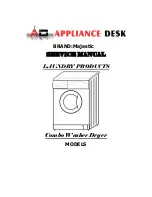
13
Finally, turn off the main switch and close the water supply faucet. The detergent and rinse-aid suction tubes will be
placed back in the containers when the machine is ready to be put back in use,
taking care so as not to invert
the tubes (red tube = detergent; transparent tube = rinse-aid).
Do not leave the device on, inactive and in disuse for long periods of time.
11 PROBLEMS AND ANOMALIES (USER)
PROBLEM
POSSIBLE CAUSE
POSSIBLE REMEDY
THE LED POWER INDICATOR
DOES NOT TURN ON
There is no electrical current
Verify the electrical current connection.
THE WASH PROGRAM DOES
NOT START
The dishwasher has not finished
loading
Wait for the
led indicator to
turn on
POOR WASHING RESULTS
Sprinkler wash holes are clogged
or encrusted
Disassemble and clean the sprinklers
(10.2 Periodic checks)
Detergent or rinse-aid insufficient
or not adequate
Verify detergent type and quantity.
Plates / glasses poorly positioned
Arrange plates / glasses accordingly.
Low wash temperature
Verify the temperature shown on the
display, if below 50°C call Assistance.
Inadequate cycle setting
Increase the duration of the wash
cycle, particularly if dishes are very
dirty or contain partially dried residues.
RINSE INSUFFICIENT
Sprinkler nozzles clogged
Calcium encrustations in the
boiler
Verify the cleanliness of the nozzles
and the correct function of any
installed water softeners.
GLASSES AND SILVERWARE
ARE STAINED
Rinse-aid inadequate or not
dispensed correctly.
Water is of a hardness level
above 12°dF or contains many
dissolved salts
Verify the rinse-aid container and
ensure its adequacy for use with the
water supply. If the problem persists
contact assistance.
WATER IS PRESENT IN THE
TANK AFTER DRAINING
Drainage tube is positioned poorly
or is partially blocked
Verify that the dishwasher’s tube and
drain are not blocked and that the
drain is not in too high of a position;
see the connection diagram.
Summary of Contents for CWC500R
Page 5: ...4 ...

































